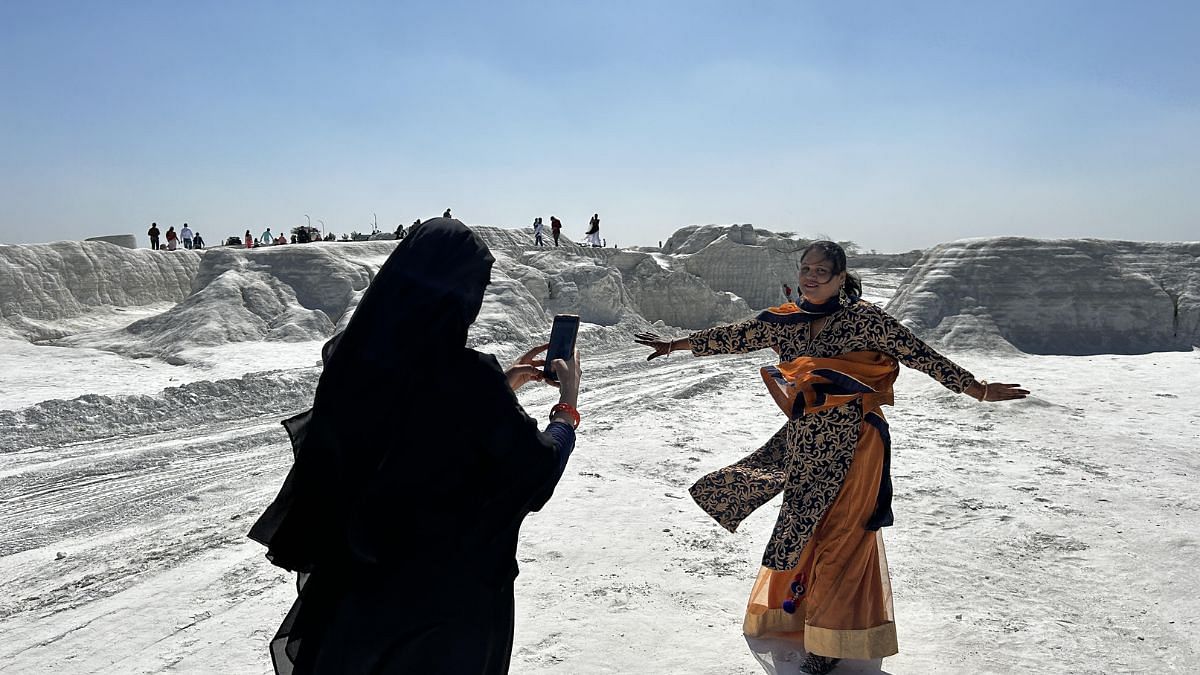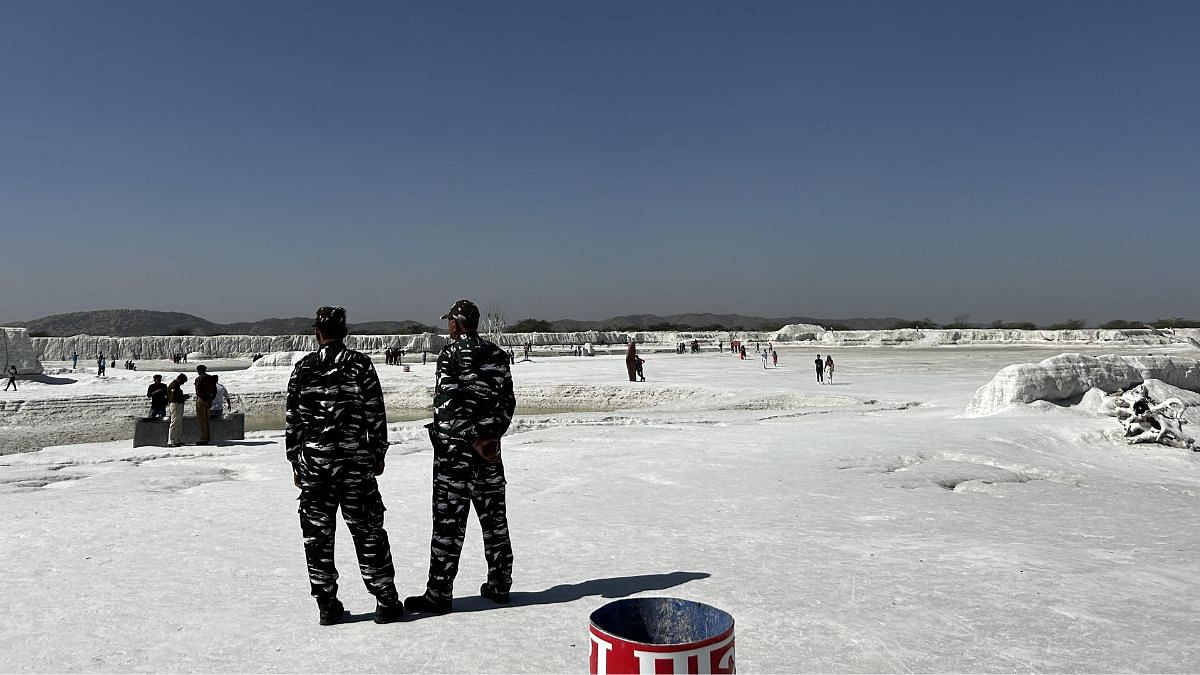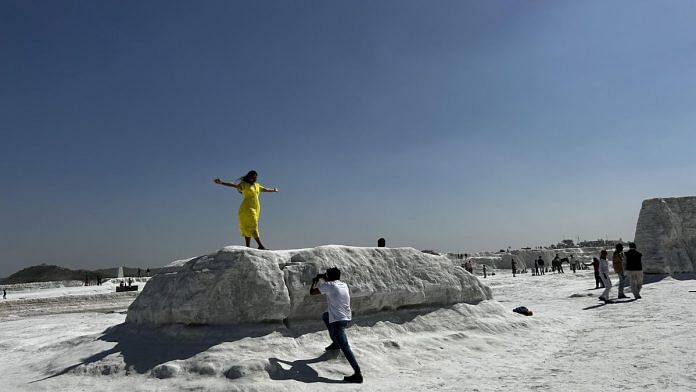Kishangarh: A truck arrived every 10 minutes at the Kishangarh dumping yard spread across 82 acres to offload the slurry marble waste. At a distance, JCBs were digging into the waste mountains. The speedy trucks and strong winds were blowing heavy dust, almost choking everyone.
But it meant little to the crowd of three thousand people who had travelled from all over north India to get that one perfect selfie at this site. Husbands posed like Shah Rukh khan, wives rocked stylish goggles and children played around rubbing their eyes that Sunday morning.


“I saw some reels and I confirmed with some friends who vouched that it is definitely a one-time watch. One can feel the snow vibe here,” Jai Verma, a Jaipur-based banker who wanted to get his photo clicked near the snow-clad tree for the last two years, said.
The crowd was left awestruck when the huge convoy of two VIPs stopped in the middle of the fake snow valley in Kishangarh. Against the backdrop of a white landscape, 15 vehicles were lined up.
A senior IPS officer got down from his vehicle to ride the white horse Raja, and his constables ran after him to take photos and videos. Another VIP, a minister and dozens of his party men stood next to the fake lake to take selfies. From Gen Z flying drones, Instagram influencers, tourists and local people—everyone tried to get as many pictures as they could.

The story of Asia’s biggest marble industry’s dumping yard turning into a reel destination isn’t an isolated case. With the growing craze for drone shoots, the polluted Yamuna in Delhi, Patna’s unbearable traffic jams and deserted Uttarakhand ghost villages, every chaos is turned into a reel which gets millions of views. In others, it instils a feeling of FOMO.
When Aakriti Rana, a fashion blogger, posted a reel of Kishangarh sometime ago, people jumped to the comment section to either reveal the location or ask about it. The reel got one million views and was shared almost thousand times.
Passed off as a cheaper version of Ladakh valley or Shimla-Manali, the stunning videos of this toxic wasteland aren’t cost-free. If you carry a camera, you pay Rs 500 for a day’s visit. A pre-wedding shoot costs Rs 5,100 per day. Commercial shoot prices get even higher. Rs 21,000 per day is charged for shooting song videos.
“Who would have thought that even a dumping yard can be turned into a revenue model?” asked SR Sharma, the chief executive officer at Kishangarh Marble Association, sitting in the shining auditorium built from the same money collected as fee to get access to the dumping yard.
“We are a role model for India,” he said with a great sense of accomplishment.
Also read: Indian institutions have a ‘brilliant moron’ problem. Only Rajeev Bhargava can save them
The trail of fame
The Expo Kishangarh Marble Industries was established in the 1980s. Some 30 years ago, the Rajasthan State Industrial Development and Investment Corporation (RIICO) allotted two dumping plots to the association. And that’s when the first marble waste was dumped here.
“With time, the waste took the shape of snow-clad mountains,” Sharma said.
The industry has 1,200 marble cutting units as of now. And the 4,500 registered businessmen employ more than 25,000 labourers. Officially, the site is spread across a radius of 50 km but Sharma claimed that when RIICO ran out of commercial land, the businessmen bought agricultural lands and converted them into commercial lands.
For years, nobody paid attention but things changed in 2015.
“Someone shot their pre-wedding shoot in 2014 here but when comedian Kapil Sharma came to shoot a song for his debut film Kis Kisko Pyaar Karoon in 2015, a crowd of 8,000 people mobbed him,” he added.
Kapil Sharma left for Mumbai after the shoot but the dumping yard had got its fame. People from nearby areas came to know that they could earn a penny. So, they brought camels, horses, and food stalls to the site. Wedding photographers from Ajmer and Jaipur started bringing couples for pre-wedding shoots. Some Punjabi and Rajasthani music companies also rushed to get the visuals of the white mountains.
More and more celebrities started turning up. Noora Fatehi shot her Chhor Denge song, Honey Singh and Nusrat Bharuccha came for the Saiyaan ji music video, and Tiger Shroff and Shraddha Kapoor shot Dus Bahane 2.0 for Baaghi 3.
Also read: Haryanvi songs are moving from vulgarity to veil — ghoonghat is sexualised, male gaze the muse
Beautification and employment
The Kishangarh Marble Association realised that waste can make money.
“We started charging a fee in 2016. The money collected from visitors goes into [beautification] work that benefits them,” Sharma said.

For every truck that gets unloaded, the pollution board charges Rs 300 per day as environmental fees, according to Deepak Tanwar, an officer posted with the pollution board.
“Both the funds were used for beautification. We planted trees, built roads to the wasteland, constructed boundaries, toilets, changing rooms and also deployed eight guards,” Sharma claimed.
Along with beautification, the association issued yearly tenders for the slurry waste so that it could be reused to make tiles. For every 10 trucks arriving at the dumping yard, one leaves for Morbi in Gujarat with slurry waste.

The association also claimed that they built a hospital.
Two years ago, Keshav, 23, realised that he could earn his livelihood at the dump yard. With five of his cousins, he got eight horses (two baby ones) and started working at the site from 8 am till sunset.
“There is Raja, Badal and Shera who get us most of the work,” said Keshav who takes Rs 1,000 each day.
But behind all the glam, fame and employment is another story.
In making a shining marble piece, 30 to 35 per cent of waste is produced. Some of the particles of this waste are smaller than 75 micrometers, which are also responsible for causing water and air pollution. Doctors in Kishangarh say that the white dust particles are responsible for a lot of skin problems, eye infections and breathing issues.
LK Sharma, environmental science professor at the Central University of Rajasthan, which is 20 km away from the Kishangarh town, said that the wasteland is responsible for causing silicosis at a large scale. It also makes the soil infertile.
“The commercial use of the dumping yard is hazardous and deploying eight guards in the close vicinity is not the right thing to do,” he added.
For precaution, local people who spend 12 hours a day at the toxic wasteland use cheap sunglasses to save their eyes and gamchha (cotton towel) to cover their noses.
“I have heard a lot about the place. The atmosphere is very healthy and the air is also very clean,” said Ganpat Lal, who visited the site with his wife and son. “It’s beautiful,” his wife said.
(Edited by Ratan Priya)






